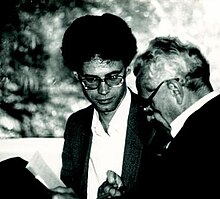Roger Heath-Brown
David Rodney "Roger" Heath-Brown (born October 12, 1952 ) is a British mathematician who deals with analytical number theory.
Life
Heath-Brown studied at Trinity College of the University of Cambridge , where he in 1973 his bachelor's degree, in 1977 his master's degree was awarded and in 1979 Alan Baker received his doctorate. In 1976 he received the Smith Essay Prize. From 1979 he was a Fellow and Reader at Magdalen College, University of Oxford , where he was a Reader from 1990. From 1999 until his retirement in 2016 he was Professorial Fellow at Worcester College, Oxford and also Professor of Pure Mathematics.
He is married and has two daughters.
plant
Heath-Brown is known for many contributions to analytical number theory. For example, he proved that there are infinitely many prime numbers of the form . He also worked on Artin's Conjecture, where he proved that among three multiplicatively independent square-free integers, there is a primitive root of infinitely many prime numbers. Another area of work at Heath-Brown is sieving methods.
With Samuel Patterson in 1979, he refuted the sorrow assumption about the value distribution of special cubic Gaussian sums.
With Leonard Adleman he proved that there are infinitely many prime exponents for which the first case of the Fermat conjecture applies.
In 2008 he brought out a new edition of the "Introduction to the Theory of Numbers" by Godfrey Harold Hardy and EM Wright and before that the book on the Riemannian Zeta function by Edward Charles Titchmarsh .
In 1992 he lowered the upper bound for Linnik 's constant in Linnik 's theorem (1944) to 5.5. Since then it has been further reduced to 5 by Triantafyllos Xylouris (2011, Dissertation Bonn), using methods from Heath-Brown. The methods used for the proof involve estimations of zero-point-free regions and the number of zeros of the Dirichlet L-function close to s = 1.
He also made important contributions to the problem of consecutive primes (see prime twin ).
Honors and memberships
Heath-Brown has been a Fellow of the Royal Society since 1993 . He is a member of the London Mathematical Society , whose Berwick Prize he received in 1981 and the Senior Berwick Prize in 1996. He has been a corresponding member of the Göttingen Academy of Sciences since 1999 . In 2009 he received the Pólya Prize . In 2016 he was elected a member of the Academia Europaea .
In 2010 he was invited speaker at the International Congress of Mathematicians in Hyderabad ( Artin's conjecture on zeros of p-adic forms ) and in 1983 in Warsaw ( Finding primes by sieve methods ). He has been a Fellow of the American Mathematical Society since 2012 .
Web links
- Roger Heath-Brown on the Oxford University website
- Roger Heath-Brown in the Mathematics Genealogy Project (English)
- CV (pdf)
Individual evidence
- ^ Heath-Brown Primes represented by , Acta Mathematica, Volume 186, 2001, pp. 1-84, online
- ^ Heath-Brown, Patterson "The distribution of grief sums at prime arguments", J. Reine Angew. Math. 310, 1979, 111-130, doi: 10.1515 / crll.1979.310.111
- ^ Adleman, Heath-Brown, The first case of Fermat's last theorem, Inventiones Mathematicae, Vol. 79, 1985, pp. 409-416
- ^ Heath-Brown: Zero-free regions of Dirichlet L-functions and the least prime in arithmetic progressions , Proc. London Math. Soc., Vol. 64, 1992, pp. 265-338, online
- ^ Heath-Brown Differences between consecutive primes , Annual Report DMV, Volume 90, 1988, pp. 71-89
- ↑ Heath-Brown Prime twins and Siegel zeros , Proc. London Math. Soc., Vol. 47, 1983, pp. 193-224
| personal data | |
|---|---|
| SURNAME | Heath-Brown, Roger |
| ALTERNATIVE NAMES | Heath-Brown, David Rodney |
| BRIEF DESCRIPTION | British mathematician |
| DATE OF BIRTH | October 12, 1952 |

